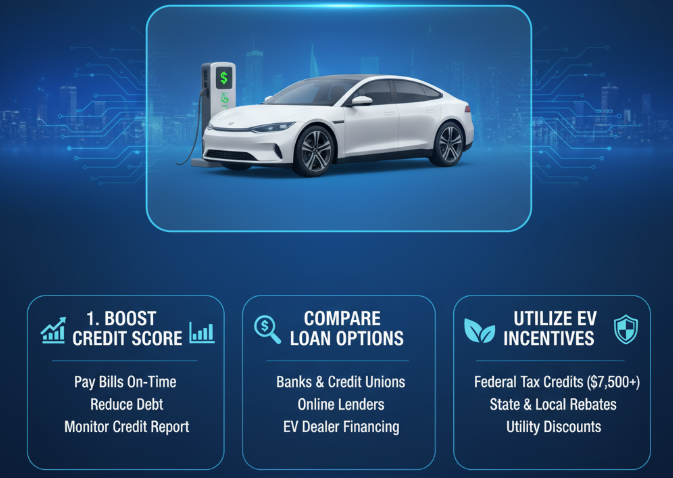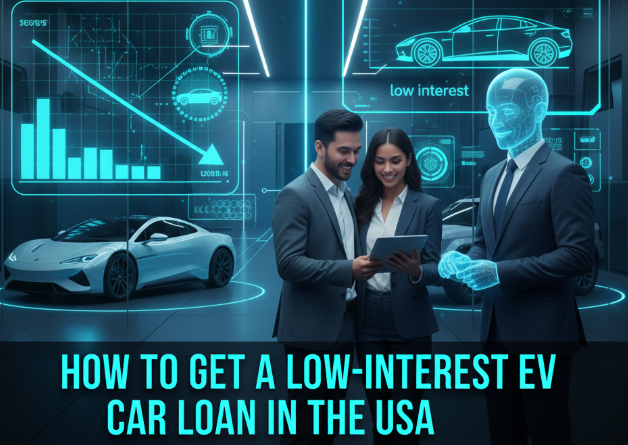Introduction
Electric Vehicles (EVs) are no longer just futuristic concepts—they’re rapidly becoming the mainstream choice for American drivers. From Tesla to Ford’s Mustang Mach-E to Chevrolet’s Bolt, EVs are everywhere. But while they save money on fuel and maintenance, one challenge remains for most buyers: how to finance the purchase affordably.
With EV prices still higher than traditional gas cars, most Americans turn to car loans. But here’s the catch: not all auto loans are created equal. The interest rate you secure can make a difference of thousands of dollars over the life of the loan.
So, how do you get the lowest-interest EV car loan in the USA? This guide breaks it down in simple steps—from preparing your finances to choosing the right lender, and even using federal and state EV incentives to lower costs.
Why a Low-Interest Loan Matters for EV Buyers
A car loan might seem like just another monthly payment, but the interest rate determines how much extra you’ll pay beyond the car’s price.
For example:
| EV Price | Loan Term | Interest Rate | Total Cost of Loan | Extra Paid in Interest |
|---|---|---|---|---|
| $40,000 | 5 years | 3% | $43,125 | $3,125 |
| $40,000 | 5 years | 7% | $47,600 | $7,600 |
👉 The difference between 3% and 7% interest is over $4,000 saved.
For EV buyers—who are often already spending more upfront—a low-interest loan can make EV ownership financially smart.
Step 1: Get Your Credit in Shape Before Applying
One of the biggest factors in your loan approval and rate is your credit score.
- Excellent Credit (720+) → Qualifies for the lowest rates (2–4% APR in many cases).
- Good Credit (660–719) → Still competitive, but slightly higher.
- Fair Credit (580–659) → Lenders see more risk, expect higher rates.
- Poor Credit (<580) → Very hard to get low rates, often above 10%.
Quick Ways to Boost Your Credit Score
- Pay down credit card balances – High utilization hurts your score.
- Avoid new debt before applying – Each hard inquiry can drop your score.
- Check your credit reports – Errors are common. You can dispute them for free at AnnualCreditReport.com.
- Make all payments on time – Even one missed payment can lower your score.
Tip: If you’re not in a rush, improving your credit for just 3–6 months before applying can unlock much lower interest rates.
Step 2: Compare Lenders (Banks, Credit Unions, Online, and EV Programs)
Not all lenders treat EV loans the same way. Some actually offer special EV financing deals to encourage adoption.
Types of Lenders to Consider
- Traditional Banks
- Example: Wells Fargo, Bank of America
- Pros: Well-known, established, wide access
- Cons: May have stricter credit requirements
- Credit Unions
- Example: Navy Federal, PenFed
- Pros: Typically lower rates than banks, member-focused
- Cons: Membership required (but often easy to join)
- Online Lenders
- Example: LightStream, Carvana Financing
- Pros: Fast approval, easy online application
- Cons: Rates can vary widely
- EV-Specific Financing Programs
- Some automakers and green banks offer special low-interest loans just for EVs.
- Example: Tesla Financing, EV-focused credit union programs
Step 3: Take Advantage of Federal and State Incentives
Did you know EV incentives can help lower your loan cost indirectly?
Federal EV Tax Credit
- Up to $7,500 off eligible EVs.
- Some 2024+ models qualify for point-of-sale rebate (reduces loan amount upfront).
State-Level EV Incentives
Each state offers its own rebates or credits. For example:
- California: Up to $7,500 rebate (plus extra for low-income households).
- New York: $2,000 rebate through Drive Clean program.
- Colorado: $5,000 state tax credit.
👉 By applying these incentives as a down payment, you reduce the loan principal, which can help you qualify for better rates and save interest long-term.
Step 4: Shop Around and Negotiate Your Rate
Many buyers make the mistake of taking the first loan offer from the dealer. This often means paying higher rates.
How to Shop Smart
- Get pre-approved: Apply to multiple lenders before visiting a dealership.
- Compare APR, not just monthly payments: A longer loan term might look cheaper monthly but cost more overall.
- Use offers as leverage: If Bank A offers 5% and Credit Union B offers 4%, you can negotiate.
Pro Tip: Dealers sometimes mark up loan rates to earn profit. Having pre-approval prevents you from being locked into high dealer financing.

Step 5: Choose the Right Loan Term
Loan term = how many months/years you’ll take to repay.
- Shorter Term (36–48 months):
- Higher monthly payments
- Lower interest rates
- Less paid overall
- Longer Term (60–84 months):
- Lower monthly payments
- Higher interest rates
- More total interest paid
Example:
| Loan Amount | Term | APR | Monthly Payment | Total Interest Paid |
|---|---|---|---|---|
| $40,000 | 36 mo | 4% | $1,179 | $2,440 |
| $40,000 | 72 mo | 6% | $659 | $7,524 |
👉 While long terms look attractive, they cost thousands more in interest.
Step 6: Consider Down Payments and Trade-Ins
The less you borrow, the less interest you’ll pay.
- Larger down payment = smaller loan.
- Trade-in value can significantly reduce loan amount.
- Even putting just 10–20% down can improve loan approval chances and rates.
Step 7: Look for EV-Friendly Loan Programs
Several lenders and programs in the USA now offer green auto loans or special EV rates.
Examples:
- EV-Only Credit Union Programs: Some credit unions provide 0.25%–0.5% APR discounts for EV purchases.
- Green Banks: Specialized institutions promoting clean energy may offer below-market EV financing.
- Manufacturer Financing: Tesla, Ford, Hyundai, and others often run limited-time promotions with 0–2.9% APR for qualified buyers.
Step 8: Be Strategic With Timing
Believe it or not, when you buy matters.
- End of the month/quarter/year: Dealers push to meet sales goals and may offer better financing.
- When new models launch: Older EVs often come with financing incentives to clear inventory.
- During federal/state EV incentive changes: Some lenders align promotions with government support programs.
Step 9: Explore Leasing vs. Buying
For some EV buyers, leasing may actually be the smarter financial move.
- Leasing Pros:
- Lower monthly payments
- Federal EV tax credit often applied by lessor as discount
- Easy upgrade to newer EV tech
- Leasing Cons:
- You don’t own the car
- Mileage limits
- Fees for wear and tear
If your goal is simply low monthly payments rather than ownership, leasing might be better than a high-interest loan.
Step 10: Use Online Tools to Calculate True Loan Costs
Before signing anything, run the numbers.
Recommended Loan Calculators:
- Bankrate Auto Loan Calculator
- NerdWallet Car Loan Calculator
- Edmunds EV Loan Estimator
These tools show:
- Monthly payments
- Total cost of the loan
- How down payments or interest changes affect your cost
Quick Checklist for Getting a Low-Interest EV Loan
✅ Improve credit score before applying
✅ Compare banks, credit unions, and online lenders
✅ Use federal/state EV rebates as down payment
✅ Get pre-approved before visiting dealers
✅ Negotiate loan terms, not just car price
✅ Choose the shortest loan term you can afford
✅ Time your purchase strategically
✅ Use loan calculators to avoid surprises
Conclusion
Buying an EV in the USA is exciting—you get the latest technology, cleaner driving, and savings on gas. But financing it smartly is just as important as choosing the right car.
By improving your credit, comparing lenders, leveraging incentives, and being strategic about terms, you can secure a low-interest EV car loan that saves you thousands over time.
Remember: a little preparation now equals huge financial benefits later. Don’t rush into the first offer—shop around, use incentives, and make lenders compete for your business.
In the end, the goal isn’t just to drive electric—it’s to drive smart. 🚗⚡

Leave a Reply